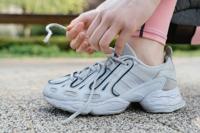
(Photo by Tirachard Kumtanom via Pexels)
By Stephen Beech
Sports footwear makers should ditch their "shrink it and pink it" approach to women’s running shoes, according to a new study.
Researchers say there is a "critical gap" in the design of running footwear as manufacturers are not taking into account the "distinct" anatomical and biomechanical needs of women compared to men.
The findings, published in the journal BMJ Open Sports & Exercise Medicine, suggest that specifically female-based designs would not only boost women runners’ comfort, but also enhance injury prevention and their performances.
Manufacturers have invested billions of pounds on the development of running shoes that can prevent injury, maximize comfort, and improve times.
But researchers who conducted the new study say both industry and academic studies have predominantly been designed for, and tested on, men and boys.
They explained that running shoes are designed by creating a three-dimensional foot-shaped mould called a "last" which is usually based on male foot anatomy.
The researchers say most sports brands use the same last for their entire range, and beyond making the shoes smaller and changing the color - a process known as "shrink it and pink it" - often only minimal changes are made to create women’s shoes.

(Photo by Ketut Subiyanto via Pexels)
The research team wanted to hear from recreational and competitive women runners which features they prioritise in a running shoe, and how those might differ across their lifespan.
The team recruited 21 participants via posters displayed at local running stores in Vancouver, Canada, with the aim of including a range of ages, running experience, and weekly running distances and frequency.
Eleven of the women were recreational runners who clocked up a weekly average of 30 kilometres (18.6 miles) ; and 10 were competitive runners, who averaged 45 kilometers (28 miles).
Nine of the participants ran during pregnancy or soon after giving birth.
Their ages ranged from 20 to 70, and their years of running experience ranged from six to 58.
The participants were asked to rank in order of importance the factors informing their choice of running shoes.
Study author Dr. Christopher Napier said: "The responses showed that their primary considerations were the comfort and feel of the shoe, injury prevention, and performance.
"In terms of comfort, most of them said they wanted a wider toe box, a narrower heel, and more cushioning.
"Competitive runners also wanted shoes incorporating performance-enhancing features, such as a carbon plate, as long as these didn’t compromise comfort."

(Photo by MART PRODUCTION via Pexels)
The participants said that they actively sought out running shoes that they believed would help prevent running injuries, and with that in mind, both groups emphasized the high value they placed on buying shoes from trusted retailers or personnel.
Dr. Napier, an Assistant Professor in the department of biomedical physiology and kinesiology at Simon Fraser University in Canada, said: "They highlighted the need for different shoe designs or components to align with different running contexts - taking part in races, training, speed work, or running with an injury, for example.
"And those who were mothers reported needing a larger shoe size and wider fit as well as more support and cushioning during pregnancy and after giving birth.
"Competitive runners also said they needed added cushioning and support features in their footwear as they got older."
The study involved just a small number of participants, and Dr. Napier acknowledged that they came from a specific geographical area, which may limit the generalisability of the findings.
But he said: “Overall, our findings highlight a critical gap in the design of running footwear, which has been traditionally based on male anatomy and biomechanics.
“While participants did not always report an inability to find footwear, their narratives reflected a process of trial-and-error adaptation, often without guidance or purpose-built solutions.
"This suggests that their needs are not proactively addressed through current footwear design or communication.”
Dr. Napier added, “We strongly recommend that the footwear industry should move beyond simply scaling down men’s shoes to fit women’s feet.
"Instead, there is a need for sex- and gender- specific designs that accommodate the distinct foot morphology of women and their social constructs and preferences, all of which evolve across the lifespan.”



















(0) comments
Welcome to the discussion.
Log In
Keep it Clean. Please avoid obscene, vulgar, lewd, racist or sexually-oriented language.
PLEASE TURN OFF YOUR CAPS LOCK.
Don't Threaten. Threats of harming another person will not be tolerated.
Be Truthful. Don't knowingly lie about anyone or anything.
Be Nice. No racism, sexism or any sort of -ism that is degrading to another person.
Be Proactive. Use the 'Report' link on each comment to let us know of abusive posts.
Share with Us. We'd love to hear eyewitness accounts, the history behind an article.